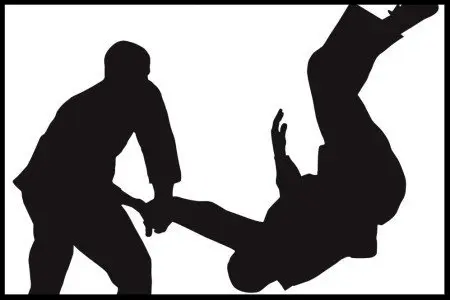
Table of Contents
Police Don’t Really Investigate
If you’re charged with injuring another person, you need an assault attorney.
Sorting out assault charges in court can be difficult. That’s because on the street, the NYPD rarely tries. This often results in police arresting the true victim, while letting the person who started the fight walk free.
A Few Assault Scenarios
Here are some typical examples of the police response to a fight between Smith and Jones:
- Police Officer: “Who called 911?”
Smith: “I did.”
The police arrest Jones. - Police Officer: “Who threw the first punch?”
Smith’s friend: “Jones did.”
The police arrest Jones. - Jones is on top of Smith when the police arrive.
The police arrest Jones. - Smith has a fat lip and a bloody nose when the police arrive.
Jones has no injuries.
The police arrest Jones. - Smith is a woman and Jones is a man.
The police arrest Jones.
What Is Assault?
New York has three basic levels of assault. They’re fairly simple to understand.
You should consult an assault attorney if you’re accused of any of these crimes, to discuss your best defense.
Assault in the Third Degree
Assault in the third degree is a misdemeanor. The maximum possible sentence is 1 year in jail. You can be charged in three different ways:
- Intentionally causing physical injury to another person. (Causing physical injury when your conscious objective is to cause physical injury.)
- Recklessly causing physical injury to another person. (Causing physical injury when you’re aware of and consciously disregard a substantial and unjustifiable risk that physical injury will occur.)
- With criminal negligence, causing physical injury to another person by means of a deadly weapon or dangerous instrument. (Causing physical injury with a deadly weapon or dangerous instrument while failing to perceive a substantial and unjustifiable risk that physical injury will occur.)
Intentional assault and reckless assault are commonly charged. Criminally negligent assault is far less common.
Assault in the Second Degree
Assault in the second degree is a class D felony. The maximum possible sentence is 7 years in jail. It has more than 14 variations. These are 4 of the most commonly charged variations:
- Intentionally causing “serious physical injury” to another person.
- Intentionally causing physical injury to another person by means of a deadly weapon or a dangerous instrument.
- With intent to prevent a police officer from performing a lawful duty, causing physical injury to such person. (No intent to cause injury is required.)
- Recklessly causing serious physical injury to another person by means of a deadly weapon or a dangerous instrument.
“Serious physical injury” means physical injury which creates a substantial risk of death, or which causes death or serious and protracted disfigurement, protracted impairment of health or protracted loss or impairment of the function of any bodily organ.
Ask your assault attorney to further explain distinctions between physical injury and serious physical injury.
Don’t Risk Assault Conviction
Schedule a FREE CONSULTATION with Bruce Yerman, Attorney at Law
Assault in the First Degree
Assault in the first degree is a class B felony. The maximum possible sentence is 25 years in jail; the minimum sentence is 5 years. It has 4 definitions:
- Intentionally causing serious physical injury to another person by means of a deadly weapon or a dangerous instrument.
- Intentionally causing serious and permanent disfigurement to another person, or intentionally destroying, amputating or permanently disabling a member or organ of another person’s body.
- Causing serious physical injury to another person under circumstances evincing a depraved indifference to human life, while recklessly engaging in conduct that creates a grave risk of death to another person.
- In the course of committing or attempting to commit a felony, or in the course of immediate flight therefrom, causing serious physical injury to another person.
Other Assaults
The Penal Law contains separate statutes that criminalize specific types of assault, such as reckless assault of a child, vehicular assault, and gang assault.
Other statutes criminalize the use or threatened use of force against another person, creating fear in another person, or creating an unacceptable risk of physical injury or death to another person. For example, menacing, hazing, reckless endangerment, stalking, obstruction of breathing, and strangulation.
Assault Defenses
You should discuss possible defenses with your assault attorney. One of these defenses or partial defenses (or another defense, or a combination of defenses) might apply to your situation:
- Your accuser has mistaken you for the actual assailant.
- If “physical injury” is an element of the crime charged, your accuser didn’t suffer “impairment of physical condition or substantial pain”.
- If “serious physical injury” is an element of the crime charged, your accuser didn’t suffer a serious physical injury.
- Your accuser has falsely accused you.
- You justifiably used force against your accuser. (This defense is commonly known as “self-defense”.)

Your Right to Self-Defense
“Justification” is the legal term in New York for your right to defend yourself against another person’s illegal use of force against you.
When properly raised as a defense, the District Attorney must disprove justification beyond a reasonable doubt.
Justification can be a powerful defense. Jurors get it. They understand that the use of force is justified under proper circumstances. Jurors can relate to defendants who use reasonable force to defend themselves.
“Justification” is a complicated area of law, with twists and turns regarding “proportionality” of force, “provocation”, “initial aggressor”, “withdrawal”, “combat by agreement”, and “the duty to retreat”.
The law distinguishes between justified use of “physical force” and justified use “deadly physical force”.
Deadly physical force is “physical force which, under the circumstances in which it is used, is readily capable of causing death or other serious physical injury”.
Mere “physical force” is non-deadly. It’s physical force which, under the circumstances in which it’s used, IS NOT readily capable of causing death or other serious physical injury.
The use of deadly physical force is justified in fewer situations than the use of mere physical force.
Self-Defense Involving “Physical Force”
You may use non-deadly physical force against another person when you reasonably believe that using such force is necessary to defend yourself from what you reasonably believe to be the use or imminent use of unlawful physical force by the other person against you, unless:
- you provoked the other person with intent to cause physical injury to the accuser; or
- you were the initial aggressor; or
- You used physical force under an illegal “combat by agreement”.
Self-Defense Involving “Deadly Physical Force”
You may not use deadly physical force against another person unless you would be justified in using regular physical force AND:
- You reasonably believes the other other person is using or about to use deadly physical force. Even then, you may not use deadly physical force if you know that you may safely retreat. But you have no duty to retreat: (i) if you’re in your “dwelling” and not the initial aggressor; or (ii) if, under certain circumstances, you’re a police officer or peace officer, or a person assisting a police officer or a peace officer at the officer’s direction; or
- You reasonably believe the other person is committing or attempting to commit a kidnapping, forcible rape, forcible criminal sexual act, robbery, or a burglary under certain circumstances.
Free Consultation
Bruce Yerman is an assault attorney in New York City. His office is located in Suite 1803 of 299 Broadway in Manhattan. If you’d like a free consultation to discuss criminal defense or family law, call Bruce at:
Or email Bruce a brief description of your situation:
